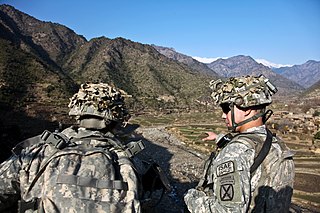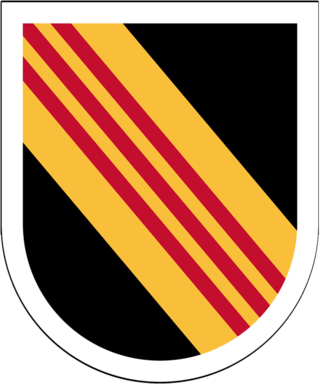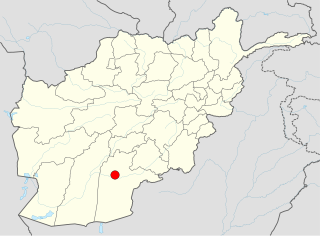
Operation Enduring Freedom (OEF) was the official name used by the U.S. government for both the first stage (2001–2014) of the War in Afghanistan (2001–2021) and the larger-scale Global War on Terrorism. On 7 October 2001, in response to the September 11 attacks, President George W. Bush announced that airstrikes targeting Al-Qaeda and the Taliban had begun in Afghanistan. Beyond the military actions in Afghanistan, Operation Enduring Freedom was also affiliated with counterterrorism operations in other countries, such as OEF-Philippines and OEF-Trans Sahara.
Humanitarian aid workers belonging to United Nations organisations, PVOs / NGOs or the Red Cross / Red Crescent are among the list of protected persons under international humanitarian law that grant them immunity from attack by belligerent parties. However, attacks on humanitarian workers have occasionally occurred, and become more frequent since the 1990s and 2000s. In 2017, the Aid Worker Security Database (AWSD) documented 139 humanitarian workers killed in intentional attacks out of the estimated global population of 569,700 workers. In every year since 2013, more than 100 humanitarian workers were killed. This is attributed to a number of factors, including the increasing number of humanitarian workers deployed, the increasingly unstable environments in which they work, and the erosion of the perception of neutrality and independence. In 2012 road travel was seen to be the most dangerous context, with kidnappings of aid workers quadrupling in the last decade, reaching more aid workers victims than any other form of attack.

A fire support base is a temporary military facility used to provide fire support to infantry operating in areas beyond the normal range of fire support from their own base camps. FSBs follow a number of plans, their shape and construction varying based on the terrain they occupy and the projected garrison.
Shkin Naryab is a town that is the capital of Gomal District, Paktika Province, Afghanistan, located about a kilometer west of the newer town and bazaar of Angur Ada in the Barmal District of Paktika. As with the area immediately to the north, the Barmal Valley, the Gomal region is primarily populated by ethnic Pashtuns, which neighbours South Waziristan in Pakistan.

The United Kingdom was one of the first countries to take part in Operation Enduring Freedom against the Taliban regime in autumn 2001.

Nāwa-I-Barakzāyi District is an administrative district in Helmand Province, Afghanistan located south of the provincial capital of Lashkar Gah along the Helmand River. It is bordered by the districts of Lashkar Gah, Nad Ali, Garmsir, and Rig, as well as the provinces of Nimruz and Kandahar. It falls within the area known as Pashtunistan,, an area comprising most of southeast Afghanistan and northwest Pakistan. The dominant language is Pashto and many of the 89,000 residents practice the traditional code of Pashtunwali. Nawa-I-Barakzayi's name reflects the dominant Pashtun tribe in the district, the Barakzai. Prior to the 1970s, it was called Shamalan after a small village at the south end of the district

The 5th Special Forces Group (Airborne) (5th SFG (A), 5th Group) is one of the most decorated active duty United States Army Special Forces groups. The 5th SFG (A) saw extensive action in the Vietnam War and played a pivotal role in the early months of Operation Enduring Freedom. 5th Group is designed to deploy and execute nine doctrinal missions: unconventional warfare, foreign internal defense, direct action, counter-insurgency, special reconnaissance, counter-terrorism, information operations, counterproliferation of weapon of mass destruction, and security force assistance.
The Battle of Firebase Anaconda was a military engagement that took place on August 8, 2007, during the War in Afghanistan. A group of roughly 75 Afghan militants mounted a rare frontal assault on a United States' Firebase Anaconda, but was repulsed with approximately 20 fatalities. No Americans were killed.
Operation Kaika was a joint operation between American Special Forces and Afghan National Army soldiers, to establish a control base as part of the larger Operation Mountain Thrust, and clear Taliban fighters from three villages about 12 miles southwest of Kandahar, Afghanistan in June 2006.

Sergeant Major Brendan W. O'Connor is a retired Special Forces medical sergeant in the United States Army. On April 30, 2008, he was awarded the Distinguished Service Cross for his heroic action in Afghanistan. The DSC is the nation's second highest award for valor and this was only the second time since the Vietnam War that the medal was awarded.

The Battle of Kamdesh took place during the war in Afghanistan. It occurred on October 3, 2009, when a force of 300 Taliban assaulted the American Combat Outpost ("COP") Keating near the town of Kamdesh in Nuristan Province in eastern Afghanistan. The attack was the bloodiest battle for US forces since the Battle of Wanat in July 2008, which occurred 20 miles (32 km) away from Kamdesh. The attack on COP Keating resulted in 8 Americans killed and 27 wounded while the Taliban suffered 150-200 killed.

Salvatore Augustine Giunta is a former United States Army soldier and the first living person since the Vietnam War to receive the United States Armed Forces' highest decoration for valor, the Medal of Honor. Giunta was cited for saving the lives of members of his squad on October 25, 2007, during the War in Afghanistan. He left the United States Army in June 2011.
The Korangal Valley campaign was a series of military operations conducted by ISAF forces against Taliban and other local insurgents in the Korangal Valley in Kunar province, Afghanistan, from October 2004 to April 2010. The campaign ended with a US withdrawal from the valley, after suffering heavy casualties, and a Taliban takeover of the area.

Operation Rock Avalanche was a six-day, US-led offensive from 19 to 25 October 2007, with the purpose of hunting Taliban fighters in the Korengal Valley of Afghanistan. The mission also aimed to establish a peace with the local populace so that a road could be safely built through the area by the Afghan government. Over the course of the operation, a series of running battles occurred with members of the Taliban, as well as with local tribesmen. U.S. Army Paratrooper Salvatore Giunta would be awarded the Medal of Honor for his actions during combat between U.S. forces and local Afghans.

The Battle of Ganjgal was a battle in the War in Afghanistan fought between American and Afghan forces and the Taliban in Kunar Province, Afghanistan on September 8, 2009. Complaints that the coalition casualties were avoidable and caused by a failure of the chain of command to provide fire support for the team triggered an official investigation and a series of reprimands to several US military officers. Army Captain William D. Swenson and Marine Corporal Dakota Meyer received the Medal of Honor for their actions during the battle. Meyer is the first living Marine to receive the Medal of Honor since the Vietnam War, and Swenson is the fifth living soldier and second officer to receive the Medal of Honor since the Vietnam War. Two other Marines at the battle, Staff Sgt. Juan Rodriguez-Chavez and Capt. Ademola Fabayo, received the Navy Cross.

America's Response Monument, subtitled De Oppresso Liber, is a life-and-a-half scale bronze statue in Liberty Park overlooking the National September 11 Memorial & Museum in New York City. Unofficially known as the Horse Soldier Statue, it is the first publicly accessible monument dedicated to the United States Army Special Forces. It was also the first monument near Ground Zero to recognize heroes of the September 11 terrorist attacks.

The Kandahar massacre, also called the Panjwai massacre, was a mass murder that occurred in the early hours of 11 March 2012, when United States Army Staff Sergeant Robert Bales murdered 16 Afghan civilians and wounded six others in the Panjwayi District of Kandahar Province, Afghanistan. Nine of his victims were children, and 11 of the dead were from the same family. Some of the corpses were partially burned. Bales was taken into custody later that morning when he told authorities, "I did it".

Robert Bales is an American mass murderer and former Army sniper who fatally shot or stabbed 16 Afghan civilians in a mass murder in Panjwayi District, Kandahar Province, Afghanistan, on March 11, 2012 – an event known as the Kandahar massacre.













